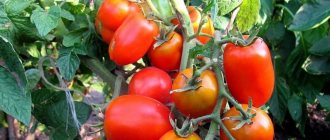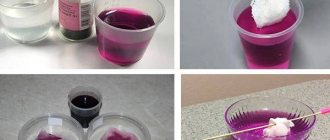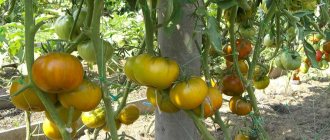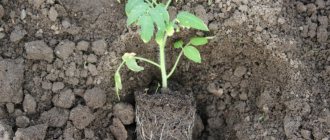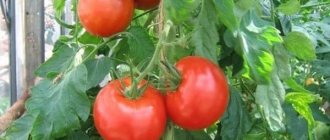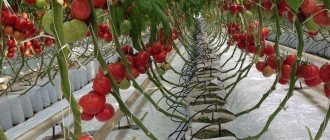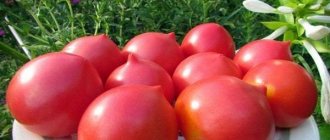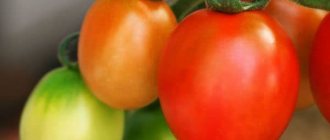How to grow a tomato: technology
The new mid-season variety is able to withstand heat and cold without significant loss of yield. The bush will grow in the open air, but it is better to plant it in a greenhouse. We will consider a detailed algorithm for growing tomatoes below.
Planting in the soil
To get a high yield, you need healthy seedlings. Seeds are sown for seedlings 2-2.5 months before planting in a permanent place of growth. To do this, fill the boxes with prepared soil, moisten them with warm water and make grooves 1 cm deep.
Before placing it in the ground, it is better to treat the seed with a weak solution of potassium permanganate (1 g per 100 ml of warm water) for rapid germination and protection of plants from diseases. Place the prepared seeds in the soil to a depth of 1 cm, bury the grooves and cover the container with glass or film until the sprouts hatch.
The optimal air temperature for seedlings is +22…+25 °C. When the shoots appear, move the container to a well-lit place. With the appearance of 2 true leaves, we perform a dive. To do this, you will need separate pots filled with substrate.
Seedlings can be grown without transplanting. To do this, seeds are sown in peat pots or tablets. When one flower cluster appears on the seedling, it is transplanted to a permanent place of growth along with the container in which it was grown.
On a note. When planting plants in the ground for 1 sq. m we have no more than 3 bushes.
At the time of planting in open ground or a greenhouse, seedlings must have at least 5 formed leaves. To transplant seedlings, prepare holes in advance. We dig holes about 10 cm deep at a distance of about 0.5 m from each other. We put 20 g of wood ash at the bottom of the holes to disinfect the soil.
We place the seedlings in the hole and dig them in so that the lowest leaf is near the ground. The stems should be slightly inclined - this is necessary for their further painless formation.
For the successful development of the plant and a good harvest, the bushes will need to be fertilized. But not all fertilizers are suitable for Red Bugai tomatoes. We carry out this procedure as follows: at the flowering stage we add a composition that includes potassium. As the fruit sets, we use a product containing phosphorus, nitrogen and potassium, using all components in equal proportions.
When filling and reddening of the fruits, change the proportions:
- reduce phosphorus by half;
- increasing the potassium intake;
- reduce the amount of nitrogen by more than half.
Potassium increases the resistance of tomatoes to disease development.
Formation and support of plants
A month after planting, we remove the leaves in the lower area of the bush. We carry out the formation carefully. Leaves located above the 3rd peduncle cannot be removed. In order not to harm the culture, we carry out the procedure in several stages. This minimizes stress on the plant. To make fruit set better, shake the bushes in the morning.
We form plants into one or two stems. For proper formation, we adhere to the following rules:
- We wear gloves;
- We do not cut off very long or too short shoots;
- we break off the stepson at a distance of 1 cm from the stem;
- We pinch the breakage area without leaving any “wounds”.
For active growth of the crop, we tie the bush to a peg, otherwise it will break due to the large weight of the fruit. You can tie the plant to a stretched wire. We do this in the following way:
- We drive in several pegs on the sides and between the rows;
- stretch a strong wire;
- As the bush grows, we lift it and tie it up, doing this in two stems.
To obtain large fruits, do not forget to pay attention to the number of clusters. If a lot of ovaries form on the brush, it is also better to tie it up so that it does not break off or get damaged
Agricultural technology for tomato cultivation
To achieve high yield, you need to grow healthy seedlings. Sowing seeds for seedlings is carried out 60-70 days before planting in a permanent place. To do this, special containers are filled with prepared soil mixture, moistened with warm water and furrows 1 cm deep are made.
Before planting in the ground, it is recommended to treat the seed with a growth stimulator to accelerate germination. The prepared seeds are placed in the soil, watered, and the container is covered with film or glass until the sprouts hatch.
Seedlings need to be grown at an air temperature of +23…+25 °C. After germination, the container is transferred to a well-lit place. When 2 fresh leaves appear, pick them. For this purpose, separate pots filled with substrate are used.
Seedlings can be cultivated without picking, sowing seeds in peat pots or tablets. Ready seedlings with one flower cluster are transferred to a permanent place along with the container in which the growing process took place.
Despite the possibility of cultivating tomatoes in open ground, greenhouse conditions are recommended for normal plant development. When planting in the ground, 2-3 bushes are placed per 1 m².
30 days after planting, you need to remove excess leaves at the bottom of the bush. In the process of forming a bush, maximum care is required. It is strictly forbidden to remove leaves located above the 3rd peduncle.
In order not to injure the bush, this activity must be carried out in several stages. This will minimize stress on the plant. To improve fruit set, shake the bushes a little in the morning.
The variety responds well to regular moderate watering at the root. To regulate the moisture balance, it is recommended to mulch the soil. This event provides drip irrigation and prevents excessive evaporation.
The hybrid is sensitive to potassium and boron deficiency in the soil. During the growing season, the plant requires intensive fertilizing with mineral fertilizers containing potassium, phosphorus, and nitrogen.
To increase the yield, it is recommended to grow the plant in 1-2 stems and remove excess branches. Tall bushes are tied to a support or trellis.
See also
Description of the Honey Drop tomato variety, its characteristics and yield
Read
To obtain giant-sized fruits, the number of peduncles and ovaries in the cluster is adjusted. Reviews from gardeners indicate that the hybrid is highly resistant to most diseases, including the tobacco mosaic virus.
The variety is susceptible to fungal diseases. If it is necessary to carry out preventive measures to protect against late blight and alternaria, it is recommended to use special preparations.
The first spraying is carried out in the formation phase of 4-6 true leaves, and subsequent treatments are carried out at intervals of 7-10 days. 20 days before harvest, stop using fungicides.
Advantages and disadvantages of the Bugai variety
Tomatoes from Siberian breeders are famous for their unpretentiousness and productivity. Bred for cultivation in difficult conditions, they, with good care, give very good results.
Advantages of the Bugai pink tomato:
- large fruits;
- mid-ripening;
- very pleasant taste;
- resistance to temperature changes;
- resistance to many diseases;
- Good yield - up to 3.5-4 kg per bush.
Pink-fruited tomatoes have excellent taste. The thing is that the fruits contain an increased amount of sugars, as well as antioxidants. The taste of pink tomatoes is brighter and richer than that of red varieties, and they are very healthy. An additional “plus” is that one large tomato is enough for a salad for the whole family.
This tomato is still positioned as a new product; in specialized stores its price is high
When purchasing, you need to pay attention to the name and description of the variety, since there is another tomato called Bugai, but only with red fruits
"Disadvantages" of the variety:
- the need to tie up and shape tomato bushes;
- enhanced fertilizing, without which it is impossible to get large fruits.
Speaking about the unpretentiousness of the Bugai pink variety, we did not mean the lack of care as such. Expecting to get a good harvest, we must not forget about following all recommendations and carrying out certain agricultural techniques. They are mostly standard, very simple, but when implemented they give good results.
Bugai tomatoes f1 description
Nov 15 • Uncategorized • 35 Views • No comments on the post Bugay tomatoes f1 description no
Contents
The red Bugai tomato was given its name because of its appropriate size and appearance. It differs from other varieties in two features - high yield and huge fruits. Give him a place in the garden, and success will be guaranteed. Breeders consider Bugai one of the most successful crossed tomatoes, and consumers speak only positively about it.
Read on to learn how to grow large and tasty tomatoes in your garden.
Landing
As a rule, seedlings are sown 60-70 days before the planned planting in the ground. Before sowing, the seeds are disinfected in a manganese solution and then soaked in a solution of a growth and development biostimulator. Plant the seeds in special containers with soil to a depth of 1-2 cm.
Landing in the ground
A few days before planting in the ground, the seedlings are taken to a cold room for hardening. 55-65 days after sowing, the seedlings are transplanted into previously prepared beds or holes.
Preparation is carried out early in the morning while it is cool in the greenhouse. To do this, you must perform the following procedures:
- dig up the beds and make grooves,
- sprinkle fertilizer along the grooves,
- pour water,
- If necessary, add compost and water again.
Plant the plant so that the top with 3-4 true leaves remains above the ground.
The rest must be carefully removed
It is important to place the stem at an angle so that later the formation of the bush is safe
The trunk should be covered with earth no more than eight centimeters.
It is better to start planting tomato seedlings in the evening.
No more than 3 seedlings should be located per square meter.
Bush formation
30 days after planting, remove excess leaves from the bottom of the stem. It is forbidden to pick off leaves after the third inflorescence.
Form a bush into one or two trunks according to the following rules:
- Use gloves.
- Do not cut off very small or very large stems.
- Leave 1-2 trunks, remove the rest.
- Stepson regularly. Break out side shoots, 5-6 cm long, at a distance of at least 1 cm from the trunk. Pinch the broken area so that the stepson no longer forms.
- Tie the stems so they don’t break off from the weight. This procedure should be performed as the bush grows.
It is convenient to attach plants to a stretched wire. To do this, you need to drive pegs along the row and pull wire or braid.
Periodically, the stems are lifted and tied.
Characteristics and description of the tomato “Bugai pink”
Everyone has difficulty choosing a tomato variety to grow. After all, productivity depends on the quality of planting material. Every gardener dreams of minimal plant care, but maximum taste and quantity of fruit.
The best thing for lazy people and beginners is the pink Bugai tomato.
Characteristics and description
On the modern market, the pink tomato variety “Bugai” appeared not so long ago. This tomato is a development of professional gardeners in Russia. Geographically, it was bred in Siberia.
The bush is tall and belongs to the indeterminate type. Its height can reach almost two meters. It has very dense stems, therefore, it is able to withstand the load of heavy fruits.
The main feature of the variety is indicated by the name “Bugai”. The tomato is a fairly large fruit. Each tomato, under the right growing conditions, can grow to almost one kilogram, on average its weight is 600 grams. According to the recommendations of scientists, “Bugai” should be grown in greenhouses; if grown in open ground, the fruits will most likely be smaller in size .
Tomatoes are slightly flat in shape, but mostly round. At the same time, the berries are very fleshy and large. The color of this type of tomato is deep pink. The pulp of the berries is elastic, juicy and sugary. Please note that there are very few seeds in tomato fruits.
Productivity of the variety
The tomato variety has gained popularity due to its productivity, because the consumer has the opportunity to collect about six kilograms of tomatoes from one bush, therefore, about 900 grams of tomatoes can ripen from one bunch.
Application
Ideal for fresh consumption, immediately after collection. For processing into tomato juice, “Bugai” is the best, as it has a moderately sour and moderately sweet taste. In canning they are used for salads, since the size does not allow you to order the whole jar.
Advantages and disadvantages
In fact, “Bugai” has a huge number of positive qualities. Even regardless of their large size, they do not burst at all, which is very surprising for such varieties. In addition to this, it has:
- high resistance to various diseases;
- the friendly emergence of seedlings and then fruits;
- ripens 110-120 days after emergence;
- does not require complex care;
- long fruiting;
- high yield.
The Bugai tomato variety is quite rich in beneficial components of group B. They can have a positive effect on the intestinal tract and stomach. Tomatoes include phosphorus, magnesium, calcium and other substances classified A, E, C.
The disadvantages include:
- the need for pinching and formation of a tomato bush;
- supporting the stem to the support;
- a large number of fake seeds;
- high price.
Features of cultivation
Sowing of seedlings occurs 55 - 65 days before planting in the ground. They should be planted in containers with special soil for seedlings (can be purchased at any store). We deepen the seeds by 1 - 2 centimeters and cover with film. You can use food grade. This way we create a greenhouse effect. The film is removed when the seedlings reach 3 - 5 centimeters in height.
As soon as you notice more than two true leaves, the plant should be pruned. The diving of the sheets occurs on the side and is absolutely necessary.
Landing in the ground
At the time of planting, the plant must have at least 5 true leaves. We plant the seedlings in pre-prepared holes. There should be one spoonful of ash at the bottom.
We plant the plant so that the first true leaf is immediately above the ground. It is important to place the stem at an angle so that it can be formed in the future without fear of damage.
Formation and support of the plant
The bush forms into one or two stems as the plant develops.
For proper formation, you should adhere to the following rules:
- We work only with gloves!
- We do not cut off shoots that are too short or too long.
- We break off the stepson at a distance of at least 1 centimeter from the stem.
- We do not leave “wounds”, but pinch the place where it breaks.
In order for the plant to grow actively, it must be tied to a peg, otherwise it may break due to heavy load. The easiest way is to tie the plant to a stretched wire.
- To begin, we place several pegs along the row.
- We stretch the wire between and and. (It is not recommended to use threads for tensioning).
- As the bush grows, we lift it up and tie it up, so we do it in two stems (that is, we branch the plant and tie it up)
To get huge fruits, you should pay attention to the number of clusters and fruits on each cluster. If you notice that many fruits can form on one brush, it should also be tied up to avoid breaking and damage.
A remedy that makes plants grow by leaps and bounds! Just water your plants with this Read more…
Adviсe
As soon as thirty days have passed after planting, excess leaves at the bottom of the stem should be removed. It is strictly forbidden to pick leaves above the 3rd inflorescence. To do everything right, the gardener must take this as carefully as possible. To avoid damaging the bush, you do not need to pull out all the excess leaves en masse; you can do this very carefully - one at a time.
In the morning, you should shake the bushes a little, this way you can promote speedy fruit setting. To keep tomatoes as large as possible, professionals advise pinching off the blossoms.
The “Bugai” tomato variety should be grown in a predominantly stable temperature regime. This is why experts advise planting tomatoes in greenhouses. In case of temperature instability, shedding of the ovaries may occur, as well as the death of the bush. If all cultivation standards are observed, the first ripening of tomatoes is observed approximately 110 days after the appearance of sprouts.
Fertilizer for tomatoes "Bugai"
Fertilizing tomatoes should not be neglected at all, since very often there are cases when the soil does not provide the bush with the necessary nutrients. To make the right choice, you should pay attention to the composition of the supplement. The composition must necessarily contain nitrogen, potassium and phosphorus. For example, potassium prevents the development of various ailments. You can use nutritional supplements in the following ways.
- initially the plant requires feeding, which contains potassium;
- As soon as fruits appear on the bushes, it needs to be fertilized with three components at once in equal quantities.
The best way to feed is by watering. Make a solution of fertilizer and water. Usually the instructions write the amount of the drug per 10 liters of water (about 200 grams) and pour half a liter of the mixture under each bush
It is very important to fertilize after loosening the soil.
Disease resistance
In general, the resistance of indeterminate plants to most diseases is at the highest level. They are not afraid:
- Tomato mosaic;
- Nematode;
- Viral and bacterial infections.
But there are diseases that can destroy the plant.
The tomato variety “Bugai” most often suffers from late blight and altenaria. These are fungal diseases. Despite the fact that the plant has little immunity to fungi, these diseases attack most often.
To avoid such inconveniences, bushes should be treated with special solutions. Treatment can begin only after four or six leaves have appeared on the plant. Repeated treatment can be carried out after seven days, and the final one – three weeks before harvesting.
Late blight is accompanied by brown spots on the leaves, they smoothly transfer to the stem and fruits. It is important to notice it in time in order to quickly eliminate it. To eliminate this, you can use special drugs. But they are advised to be used only when the plant is neglected.
In the initial stages, you can use home remedies.
- In a bucket of water (10 liters), dilute one glass of lime, add one spoon of copper sulfate. Mix very well and let it brew for several hours. We remove all damaged leaves and bushes treated with this mixture.
- Soap solution no less for late blight. Rub 1 piece of laundry soap into 10 liters of water, add 1 tablespoon of calcined salt, mix. Just as in the previous method, we remove the damaged areas and spray the plant with the resulting solution.
- Take a bucket of hot water. Dissolve 2 grams of potassium permanganate in it. Chop the head of garlic and add it to the bucket. Mix well, let cool and water the beds. A mixture of potassium permanganate and garlic has a strong anti-fungal effect.
All of the above remedies will also be effective against altenaria, because this disease is also a fungal disease and manifests itself with almost the same symptoms. But the color of the spots is very bright and very quickly transfers to the entire plant. Therefore, if half of the bush is covered with spots of altenaria, it is completely removed.
Conclusion
As you already understand, the Bugai tomato variety is very popular among gardeners. On the Internet you can find many reviews, which are mostly positive. In particular, gardeners note that the germination rate of this variety is very high, the tomatoes are very large, and also have a very tasty and rich taste. It is also noted that tomatoes actually grow from 800 to 1000 grams.
It should be noted that gardeners speak extremely positively about this variety of tomatoes.
Reviews
Alex
I love “Bugai” very much for its size, yield and taste. The whole family loves salads with these tomatoes and tomato juice. “Bugai” gives some unusual taste.
As for growing, I wouldn't say it's difficult. I can only note the fact that when you form a bush, you need to rinse your hands in a solution of potassium permanganate, otherwise there is a chance of infecting the plant. And in order not to reduce its immunity to late blight, you cannot cut off the stepsons close to the stem and those that are more than 8 centimeters.
District
In fact, there is little information about tomatoes of this variety, because it was bred not so long ago.
For a long time I could not find anything about him. I had to learn everything from my own experience and want to share it with everyone.
If you do not treat the seeds with potassium permanganate, expect late blight. Of course, licensed seeds are processed very carefully to avoid various kinds of diseases, but all treatments against this disease are effective within 3 days. And you cannot know for sure how long the seeds have been lying around.
The second thing I can say is to loosen the soil once a week. In greenhouses and greenhouses, it tends to stagnate and does not provide air to the roots.
Well, when harvesting, if you want to get fruits right up to September, then pick the tomatoes carefully without damaging the trusses.
osortah.ru
Tomato "Dubok": description of the variety
| Variety name | Oak |
| general description | Early ripening, determinate variety of tomatoes |
| Originator | Russia |
| Ripening period | 85-105 days |
| Form | Round, slightly flattened |
| Color | Red |
| Average weight of tomatoes | 50-100 grams |
| Application | Universal |
| Productivity of the variety | 6 kg per sq. meters |
| Features of cultivation | Standard agricultural technology |
| Disease resistance | Resistant to major tomato diseases |
These tomatoes are intended for growing in open ground, but they are also grown in greenhouses, greenhouses, under film and even indoors
What is important about the characteristics of Dubok tomatoes is that they are extremely resistant to late blight, as well as other diseases
This variety is not a hybrid and does not have any F1 hybrids of the same name.
The first inflorescence on these plants usually forms above the sixth or seventh leaf, and all the rest - through one leaf. The main stem has five or six inflorescences, and each cluster bears five or six fruits. About 6 kilograms of tomatoes are usually harvested from one square meter of land.
You can see the yields of other varieties in the table below:
| Variety name | Productivity |
| Oak | 6 kg per square meter |
| Kate | 15 kg per square meter |
| Nastenka | 10-12 kg per square meter |
| Crystal | 9.5-12 kg per square meter |
| Dubrava | 2 kg per bush |
| Red Arrow | 27 kg per square meter |
| Golden Jubilee | 15-20 kg per square meter |
| Verlioka | 5 kg per square meter |
| Diva | 8 kg per bush |
| Explosion | 3 kg per square meter |
| Golden heart | 7 kg per square meter |
IMPORTANT! When growing Dubok tomatoes indoors, it is necessary to carry out artificial pollination of flowers.
The most preferred predecessors for Dubok tomatoes are lettuce, carrots, cabbage, cucumber, onion and legumes.
Prevention of diseases and pests
Indeterminate plants are resistant to most diseases. They are not afraid of bacterial and viral infections, mosaic, and muteness.
But there are diseases that can destroy the entire plant. The Bugai variety most often suffers from fungal infections - Alternaria and late blight.
Late blight manifests itself as brown spots on the leaves, which gradually spread to the stem and fruits. The main thing is to notice them in time and eliminate them immediately. To prevent infection, we treat the bushes with special solutions. We begin processing when 4-6 leaves appear.
We carry out repeated treatment after a week, and the last one – 5 days before harvest.
To prevent fungal diseases, experienced summer residents advise using home remedies:
- Add 1 glass of lime and 1 spoon of copper sulfate to a bucket of water (10 l). Mix the contents and let it brew for 1-2 hours. Then we remove the damaged leaves and treat the bushes with the prepared mixture.
- Also, a soap solution is effective for late blight. Rub 200 g of laundry soap into 10 liters of water and add 1 tablespoon of calcined salt. Mix well. We remove the affected areas and spray the plant with the resulting solution.
- Dissolve 2 g of potassium permanganate in a bucket of hot water, chop and add a head of garlic to the solution. Stir, let cool and water the beds. The mixture fights fungi well.
Such remedies are also effective against Alternaria, because this is also a fungal disease. It manifests itself with almost the same symptoms as late blight, but the spots have a brighter color and quickly spread throughout the plant. If the disease has affected half the bush, the plant must be completely removed.
The opinions of experienced agronomists and novice summer residents regarding Bugai red tomatoes mostly agree that the variety is worthy of attention. Here are reviews from some gardeners.
Vyacheslav, Voronezh: “I once bought Bugai tomato seeds. I planted it, the bush grew powerful, but not much foliage formed. I formed a bush into two stems, the brushes came out very well. The fruits have grown large in size and have an almost ideal shape. The tomato tastes sweet and sour, fleshy and juicy. But I must warn you that this variety needs abundant feeding, especially potassium and phosphorus. I grew bushes in two greenhouses, did not calculate the feeding and deprived one bush. Therefore, an uncharacteristic spot formed on the plant near the stalk, and the fruits themselves grew with veins. I picked these tomatoes both ripe and green, and they ripened perfectly. The whole family ate the tomato fresh. I didn’t dare to make preparations with them, since the tomatoes turned out to be too big.”
Alexander, Samara: “I am an experienced gardener. I really like to grow the Bugai F1 tomato for its large size, high yield and great taste. My whole family likes the juice and salads made from these fruits. Bugai has some kind of peculiar taste. The growing process can hardly be called complex: Bugai requires no less attention than other crops. As more experienced summer residents advised me, when forming bushes, it is advisable to rinse your hands in a slightly pink solution of manganese. This technique will prevent possible plant infection. To prevent the plant’s immunity to late blight from decreasing during the care process, the stepsons should not be cut off close to the stem. You need to leave at least 8 cm of shoot on the stem.”
Valentin, Orel: “I’ve been planting the Bugai tomato for three years now. The first time I planted the crop directly in open ground, but in the end I was not at all happy with the result. The tomatoes were not formed and ripe as large as in the photo of the package with seeds. A tall bush needs a garter, otherwise the tomatoes will be on the ground. That year I planted it in a greenhouse. As advised, I tied it up, watered it on time, and applied fertilizer. In the end, my efforts paid off. The neighbors couldn't believe that I had grown this beauty myself. I liked the variety. I will continue to grow.”
Advantages and disadvantages
The positive aspects include the rich fertility of the plant. There are so many ovaries on one branch that the stepsons have to be removed. Tomatoes are also valued for their most balanced acid and sugar content. They are not picky about feeding and respond well to abundant watering. Although the berries reach quite impressive sizes, they never crack.
Unfortunately, this tomato variety requires abundant feeding with microelements and fertilizers throughout the entire ripening period. Tomatoes are very susceptible to insect attacks and also require protection from late blight, so treatment with Ordan will be an integral part of care.
Bugai is quite picky about the condition of the soil and reacts poorly to a lack of potassium and boron in the soil. Since tomato bushes reach considerable heights, the plant needs systematic staking. The culture also requires a special temperature regime - in no case should this indicator be neglected, since the newly formed ovaries will begin to crumble.
Rules for harvesting and storing crops
You can start harvesting tomatoes of the Krasavchik variety in late July - early August. If, after completing this procedure, you want to send the fruits for long-term storage, then collection should be carried out exclusively in dry weather and best in the morning. Large, healthy, not overripe fruits without visible skin defects should be selected.
Containers for storing tomatoes can be very different - from cardboard boxes to plastic boxes, the bottom of which is covered with paper. The lid of boxes and boxes should be selected so that when closing it does not put pressure on the tomatoes. It is best to cover plastic containers on top with burlap or other fairly dense material. This is due to the need to preserve ethylene, which has a positive effect on tomatoes.
We advise you to read what you need to do to make tomatoes turn red faster.
The place where fruits are stored is no less important - it is not recommended to use a cellar for this purpose, since in conditions of high humidity they will quickly rot. In winter, the air temperature in the room where the crop is stored must be monitored especially carefully, otherwise the fruit will freeze
If the tomatoes have been selected for long-term storage, do not forget to regularly inspect them for the presence of rotten and diseased specimens, because by taking timely measures, you can save the rest of the harvest.
From the very beginning of its appearance on the market, the Krasavchik tomato variety has proven itself to be one of the best for growing. The positive reputation and reviews of experienced gardeners leave no doubt about the excellent taste of the variety, its unpretentiousness and high yield, and therefore it is an excellent choice for growing both in a greenhouse and in open ground.
Advantages of the variety
The Pink Bugai tomato belongs to the first generation hybrids. The variety is characterized by an average ripening period. The plant is of a determinate type, during the growing season it forms a bush 150-180 cm high. A crop with thick stems, which is due to the need to withstand the weight of ripening tomatoes.
Large, flat, round tomatoes with an intense pink color ripen on the bush. The weight of the fruit reaches 600 g. Tomatoes have dense pulp, sugary at the break; the chambers contain a small amount of seeds.
Large tomatoes are not prone to cracking during ripening. The description of the variety is associated with excellent taste. In cooking, the fruits are used fresh for making juices, pastes, and purees.
The hybrid is characterized by high yield. From 1 bush you can remove 5 kg of fruits, and from one branch - up to 2 kg of ripe tomatoes.
The Bugai red tomato differs from the pink variety only in color. It is characterized by large fruits and high productivity. During the growing season, the plant reaches a height of 150 cm.
A tomato with an average early ripening period begins to bear fruit 115 days after emergence. The weight of tomatoes reaches 800-1000 g. The total yield during the season is 6 kg of fruits per bush. The variety has a long fruiting period.
The fruit has a balanced sugary taste with an inherent sour note. Tomatoes are used fresh. The harvest, harvested at the stage of biological ripeness, ripens well in the warmth.
Description and characteristics of the variety
Bugai red is a determinate tall variety. The shoots grow up to 1.5 m. The tomato belongs to the mid-early group - ripening begins 110-115 days after germination. The plant bears fruit for a long time from June until the end of summer.
Tomato Bugai red from “Siberian Garden” produces tomatoes weighing 800-900 g. Tomatoes with a total weight of 2 kg are placed on 1 brush. The fruits do not crack and are well transported.
Features of cultivation and storage
It is possible to grow tomatoes in open beds, but in greenhouses these tomatoes show much better results. The variety is characterized by a powerful root system; it requires a lot of space, so it is undesirable to thicken the plantings.
Salad variety, designed for quick processing. When ripe, these tomatoes are not stored, but they ripen well in room conditions.
Sowing begins 60-70 days before the intended planting in a permanent place. Before this, the seeds are disinfected in a solution of potassium permanganate and soaked in a solution of a biostimulator of growth and development. For better formation of the root system, seedlings are planted in the phase of 1-2 true leaves. The plant is considered ready for transplantation after the formation of the first flower cluster.
Caring for tomatoes is not difficult, so even the least experienced gardener can cope with growing them.
- Water in the evening, when there is no direct sunlight. Tomatoes need abundant watering during the growth and flowering stages, and then, during the period of fruit development and ripening, watering is reduced.
- For better formation of the ovary, Bugay is fed with fertilizers containing potassium.
- Planting begins 25-30 days after planting in the greenhouse.
- Tomato roots need access to air, so after watering the soil is loosened. You can avoid this procedure. To do this, the beds with tomatoes should be mulched with straw or hay.
- Plants must be treated with phytosporin to prevent fungal diseases.
Early maturing / Tall
User rating: 5/5
Early maturing / Tall
User rating: 4/5
Mid-season / Tall
Tomato “Bugai” is a mid-season ripening variety. It achieves the best results when planted in a greenhouse and very carefully cared for.
Tomato “Bugai pink” should be pinched during plant growth. Usually one or two main branches are left and the rest are removed.
25-30 days after planting in the greenhouse, the plants must be pinched - the lower leaves are removed. Tomato “Bugai pink” requires abundant watering and frequent feeding. For successful formation of the ovary, potassium fertilizers are immediately used. And only when the fruits have already set do we begin to fertilize with a mixture of nitrogen-phosphorus-potassium.
Tomato “Bugay pink” is a very heat-loving variety. For successful ripening, it needs a temperature within 23-25 degrees. It is demanding on watering, timely ventilation in the greenhouse, and will not tolerate drafts. Tomato “Bugai” is a rather demanding variety of tomato, but with effort, it will reward you with an excellent harvest.
To control and prevent pests and fungal diseases, it should be treated with special preparations. Timely potassium feeding will also help him cope with the scourge.
How to grow tomatoes
Seedlings can be purchased in the store in ready-made form. But it's better to do it yourself. Moreover, this is a fairly simple procedure. Sowing of seedlings begins in March or late April. Sowing dates depend on weather conditions in the region. If a given area is characterized by an early and warm spring, then you can sow tomatoes earlier.
Then planting in the ground will be carried out earlier. Seedlings are planted in mid or late May. For regions with a cool climate, the timing is different. Tomatoes are sown at the end of April, and at the beginning of May the seedlings are transplanted into the ground. From the moment of sowing the seeds to planting in open ground, 60 days should pass.
The first few days after planting seedlings in open ground, there is no need to water the plant. They do this so that the bushes take root well. In search of moisture, the roots will stretch deep into the soil. The soil for tomatoes must be well prepared. They need well-drained soil. Neutral soil is best.
Growing tomatoes
The "Geisha" variety is grown through seedlings.
How to prepare seeds?
Proper preparation of seed material:
- Planting material must be disinfected using a weak solution of manganese. The seed material is placed in the solution for 30 minutes. Then rinse in clean water;
- Then the seeds are soaked in a growth stimulator for 10-12 hours.
Sowing seed material
Recommendations for proper sowing of seeds for seedlings:
- Start sowing seed material for seedlings in March;
- Since the tomato crop places increased demands on the soil composition, it is recommended to use a mixture of garden or turf soil with the addition of humus. The presence of superphosphate and sifted wood ash is also required. You can use purchased soil mixture;
- Sow in containers or small peat pots. Containers with sown seeds are covered with film and left in a warm room;
- As soon as the first shoots appear, the film is removed and the temperature in the room is lowered. Containers with seedlings are placed in a well-lit place;
- Throughout their growth, seedlings need moderate watering with warm, soft water;
- If sowing was carried out in separate pots, no picking is carried out; the seedlings are simply transplanted into the ground directly in the pots. When sowing seed material into a common container, as soon as two true leaves are formed, begin picking;
- Afterwards, the young shoots are fed using a complete complex fertilizer. The second feeding is carried out after 14 days;
- A week before the planned date of planting in a permanent place, the seedlings begin to be hardened off in order to speed up the adaptation period in the new place.
